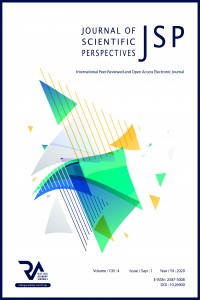Öz
Anahtar Kelimeler
Electrochemical DNA Biosensor Tamoxifen Differential Pulse Voltammetry (DPV) Commercial Drug Tablet Recovery Work.
Kaynakça
- BAGNI G, MASCINI M., 2010, DNA biosensor for environmental risk assessment and drugs studies. In: Sensors for Chemical and Biological Applications, 249–276.
- CAN S., YILMAZ S., SAGLIKOGLU G., SADIKOGLU M., MENEK N., 2015, Electrocatalytic oxidation of acyclovir on poly (p-aminobenzene sulfonic acid) film modified glassy carbon electrode, Electroanalysis, 27, 2431.
- HURTADO-MONROY R., VARGAS-VIVEROS P., CARRILLO-MUÑNOZ S., DUENAS-GONZALEZ A., 2007, Tamoxifen-associated vasculitis in a breast cancer patient, World Journal of Surgical Oncology, 5-7.
- JAHANDARI S., TAHER M. A., KARIMI-MALEH H., KHODADADI A., FAGHIH-MRZAEI E., 2019. A Powerful DNA-based voltammetric biosensor modified with au nanoparticles, for the determination of temodal; an electrochemical and docking investigation. Journal of Electroanalytical Chemistry, 840, 313-318.
- KELSEY J. L., BERNSTEIN L., 1996, Epidemiology and Prevention of Breast Cancer, Annual Review of Public Health, 17:47-67.
- MOGHADDAM H. M., BEITOLLAHI H., DEHGHANNOUDEH G., FOROOTANFARD H., 2017, The electrochemical society a label-free electrochemical biosensor based on carbon paste electrode modified with graphene and ds-dna for the determination of the anti-cancer drug tamoxifen, Journal of The Electrochemical Society, 164 (7) 372-376.
- OSBORNE C. K.,1998, Tamoxifen in the treatment of breast cancer, N Engl J Med, 339:1609-1618.
- OZKAN D., KARADENIZ H., ERDEM A., MASCINI M., OZSOZ M., 2004, Electrochemical genosensor for mitomycin c- dna interaction based on guanine signal, Journal of Pharmaceutical and Biomedical Analysis, 35(4): 905-912.
- R. D. SYNDER, J. E. BROWN, 2002, Evidence for and role of the dimethylamino group in tamoxifen DNA intercalation in intact chinese hamster v79 cells, Drug Chem Toxicol., 25(4):473-9.
- SADIKOGLU M., YILMAZ S., KURT I., SELVI B., SARI H., ERDURAN N., USTA E., SAGLIKOGLU G., 2016, Electrocatalytic oxidation of hydrazine on poly (4 aminobenzene sulfonic acid)-modified glassy carbon electrode, Russian J. Electrochem. 52, 603.
- SUBAK H., OZKAN-ARIKSOYSAL D., 2018. Label-free electrochemical biosensor for the detection of ınfluenza genes and the solution of guanine-based displaying problem of dna hybridization. Sens. Actuators B, 263, pp. 196-207.
- TEUNISSENS.F., ROSING H., SCHINKELA.H., SCHELLENSJ.H.M., BEIJNENJ.H.,2010, Bioanalytical methods for determination of tamoxifen and its phase I metabolites: a review, Analytica Chimica Acta, 683, 21-37.
- GUPTA V.K., JAIN R., RADHAPYAII K., JADON N., AGARWAL S., 2011, Voltammetric techniques for the assay of pharmaceuticals-a review, Anal. Biochem., 408, 79-196.
- YANG Q., BENSON L. M., JOHNSONK.L., NAYLORS., 1999, Analysis of lipophilic peptides and therapeutic drugs: on-line-nonaqueous capillary electrophoresis-mass spectrometry.J. Biochem. Biophys. Methods, 38, 103-121.
Öz
Anahtar Kelimeler
Electrochemical DNA Biosensor Tamoxifen Differential Pulse Voltammetry (DPV) Commercial Drug Tablet Recovery Work.
Kaynakça
- BAGNI G, MASCINI M., 2010, DNA biosensor for environmental risk assessment and drugs studies. In: Sensors for Chemical and Biological Applications, 249–276.
- CAN S., YILMAZ S., SAGLIKOGLU G., SADIKOGLU M., MENEK N., 2015, Electrocatalytic oxidation of acyclovir on poly (p-aminobenzene sulfonic acid) film modified glassy carbon electrode, Electroanalysis, 27, 2431.
- HURTADO-MONROY R., VARGAS-VIVEROS P., CARRILLO-MUÑNOZ S., DUENAS-GONZALEZ A., 2007, Tamoxifen-associated vasculitis in a breast cancer patient, World Journal of Surgical Oncology, 5-7.
- JAHANDARI S., TAHER M. A., KARIMI-MALEH H., KHODADADI A., FAGHIH-MRZAEI E., 2019. A Powerful DNA-based voltammetric biosensor modified with au nanoparticles, for the determination of temodal; an electrochemical and docking investigation. Journal of Electroanalytical Chemistry, 840, 313-318.
- KELSEY J. L., BERNSTEIN L., 1996, Epidemiology and Prevention of Breast Cancer, Annual Review of Public Health, 17:47-67.
- MOGHADDAM H. M., BEITOLLAHI H., DEHGHANNOUDEH G., FOROOTANFARD H., 2017, The electrochemical society a label-free electrochemical biosensor based on carbon paste electrode modified with graphene and ds-dna for the determination of the anti-cancer drug tamoxifen, Journal of The Electrochemical Society, 164 (7) 372-376.
- OSBORNE C. K.,1998, Tamoxifen in the treatment of breast cancer, N Engl J Med, 339:1609-1618.
- OZKAN D., KARADENIZ H., ERDEM A., MASCINI M., OZSOZ M., 2004, Electrochemical genosensor for mitomycin c- dna interaction based on guanine signal, Journal of Pharmaceutical and Biomedical Analysis, 35(4): 905-912.
- R. D. SYNDER, J. E. BROWN, 2002, Evidence for and role of the dimethylamino group in tamoxifen DNA intercalation in intact chinese hamster v79 cells, Drug Chem Toxicol., 25(4):473-9.
- SADIKOGLU M., YILMAZ S., KURT I., SELVI B., SARI H., ERDURAN N., USTA E., SAGLIKOGLU G., 2016, Electrocatalytic oxidation of hydrazine on poly (4 aminobenzene sulfonic acid)-modified glassy carbon electrode, Russian J. Electrochem. 52, 603.
- SUBAK H., OZKAN-ARIKSOYSAL D., 2018. Label-free electrochemical biosensor for the detection of ınfluenza genes and the solution of guanine-based displaying problem of dna hybridization. Sens. Actuators B, 263, pp. 196-207.
- TEUNISSENS.F., ROSING H., SCHINKELA.H., SCHELLENSJ.H.M., BEIJNENJ.H.,2010, Bioanalytical methods for determination of tamoxifen and its phase I metabolites: a review, Analytica Chimica Acta, 683, 21-37.
- GUPTA V.K., JAIN R., RADHAPYAII K., JADON N., AGARWAL S., 2011, Voltammetric techniques for the assay of pharmaceuticals-a review, Anal. Biochem., 408, 79-196.
- YANG Q., BENSON L. M., JOHNSONK.L., NAYLORS., 1999, Analysis of lipophilic peptides and therapeutic drugs: on-line-nonaqueous capillary electrophoresis-mass spectrometry.J. Biochem. Biophys. Methods, 38, 103-121.
Ayrıntılar
| Birincil Dil | İngilizce |
|---|---|
| Bölüm | Basic Sciences and Engineering |
| Yazarlar | |
| Yayımlanma Tarihi | 31 Ocak 2020 |
| Yayımlandığı Sayı | Yıl 2020 Cilt: 4 Sayı: 1 |


